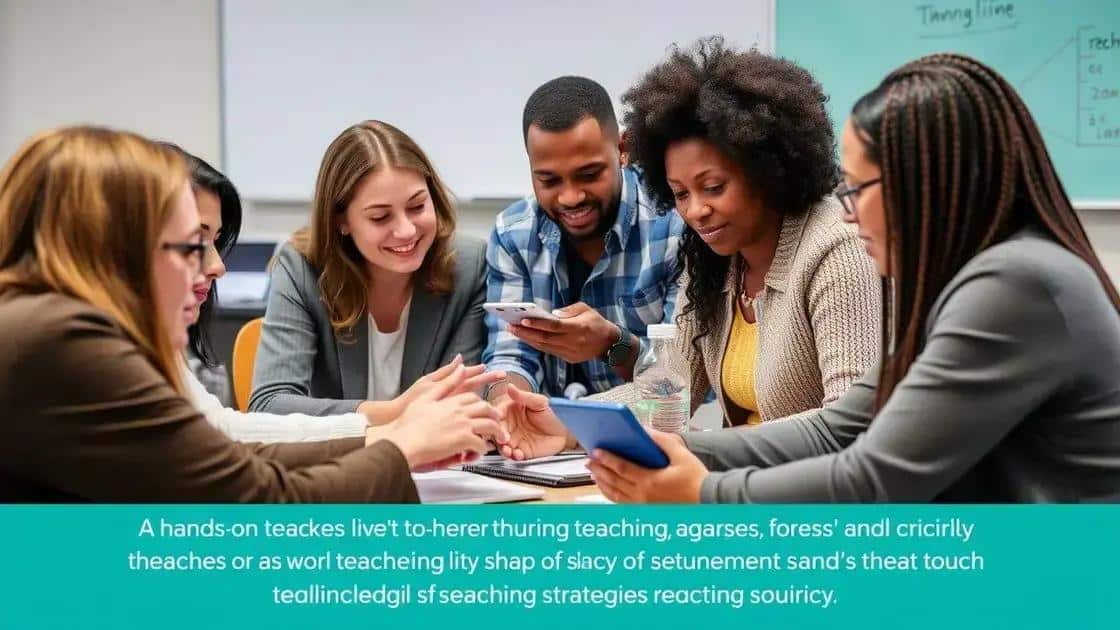Teacher professional development: unlock your potential

Teacher professional development focuses on enhancing educators’ skills through feedback, collaboration, and continuous learning, ultimately improving teaching effectiveness and student outcomes.
Teacher professional development is more than just a requirement; it’s a key to unlocking your potential in the classroom. Have you ever wondered how these programs can transform your teaching approach and benefit your students? Let’s dive into the innovative strategies that can help you grow.
Understanding the importance of teacher professional development
Understanding the importance of teacher professional development is crucial for educators at any stage of their careers. This ongoing learning helps teachers remain effective in their ever-changing classrooms, where new strategies and technologies emerge constantly.
As schools evolve, the need to enhance teaching methods grows. Participating in professional development gives teachers new insights and tools to engage their students. It’s not just about learning; it’s about growing and adapting to meet the needs of 21st-century learners.
Benefits of Professional Development
There are many benefits to engaging in teacher professional development. It can lead to:
- Improved teaching skills and methodologies.
- Higher student engagement and achievement.
- Enhanced collaboration with colleagues.
- Increased confidence in handling classroom challenges.
Each of these benefits contributes to better educational outcomes. When teachers learn new techniques, they can apply them immediately in their classrooms.
Why Are Teachers Reluctant?
Despite the benefits, some teachers are hesitant to participate in professional development. Common concerns include:
- Time constraints due to busy schedules.
- Doubt about the relevance of the training provided.
- Fear of not being able to implement new ideas.
By addressing these concerns and providing relevant programs, schools can encourage more teachers to take the leap. It’s essential to offer flexible options that fit into their schedules and demonstrate the real-world applications of what they are learning.
In conclusion, understanding the importance of teacher professional development is not just about mandatory courses; it’s about nurturing a culture of growth and improvement in education. When teachers embrace continuous learning, everyone benefits—especially the students.
Effective strategies for ongoing teacher growth

Effective strategies for ongoing teacher growth are essential for educators seeking to improve their skills continuously. With the right approach, teachers can foster their development while enhancing student learning experiences.
One effective method is setting personalized goals. When teachers identify specific areas for improvement, they can focus their efforts more efficiently. This process not only promotes accountability but also encourages teachers to seek resources aligned with their goals.
Engagement in Collaborative Learning
Working with peers is another powerful strategy. Engaging in professional learning communities allows teachers to share insights and strategies. Benefits of collaboration include:
- Exchanging diverse teaching ideas and resources.
- Receiving constructive feedback from colleagues.
- Building a support network that fosters motivation.
- Developing team-based projects that enhance classroom learning.
Through collaborative efforts, teachers can feel more connected and inspired in their roles.
Utilizing Technology for Professional Growth
Incorporating technology into professional development can also make a significant difference. Online courses and webinars offer flexibility, allowing teachers to learn at their own pace. Some beneficial platforms include:
- Webinars focused on specific topics in education.
- Online courses that grant certifications.
- Virtual conferences that provide networking opportunities.
This tech-savvy approach makes access to quality training easier and supports teachers in their growth journey.
Overall, implementing these effective strategies empowers teachers to continue evolving in their profession. By setting personalized goals, engaging with peers, and utilizing technology, they can create a more enriching environment for their students.
How to choose the right professional development program
How to choose the right professional development program is a crucial step for teachers looking to enhance their skills and effectiveness. With many options available, selecting the best program can feel overwhelming. However, a clear process can help ease this decision.
Start by identifying your learning goals. Consider what skills you want to improve or which areas of study excite you. Knowing what you want to achieve will guide you in finding the most relevant professional development programs.
Assessing Program Quality
Next, evaluate the quality of the program. Look for these key factors:
- Accreditation from recognized educational organizations.
- Positive reviews from past participants.
- Qualified trainers with a strong background in pedagogy.
- Availability of practical, hands-on learning experiences.
These elements can indicate whether a program will be effective in enhancing your skills.
Considering Time and Format
Time and format are also important when choosing a professional development program. Determine how much time you can commit and whether you prefer in-person training or online options. Some programs may offer:
- Flexible scheduling to fit into your busy life.
- Online classes that can be accessed anytime.
- Intensive workshops for quick skill acquisition.
Choosing a format that suits your needs will help you stay motivated and engaged throughout the learning process.
Finally, don’t forget to consider the cost. Explore whether your school or district supports professional development financially. Investing in quality training can pay off, but it’s essential to find options that fit within your budget.
Incorporating feedback for continuous improvement

Incorporating feedback for continuous improvement is essential for teachers striving to enhance their practice. Feedback acts as a guide, helping educators identify strengths and areas for growth. Actively seeking and using feedback fosters a culture of learning and development.
One effective way to gather feedback is through peer observations. Teachers can visit each other’s classrooms and observe different teaching styles. This firsthand experience allows them to understand various techniques and reflect on their own methods.
Using Student Feedback
Another valuable source of feedback comes from students. Educators can create anonymous surveys or hold discussions to gather their thoughts on lessons. Important aspects to focus on include:
- Understanding what students enjoy about their learning experience.
- Identifying topics that may require a different approach.
- Gathering suggestions for activities or resources that engage students.
Incorporating this insight is key to making lessons more effective and engaging.
Self-Reflection Practices
In addition to seeking external feedback, self-reflection is a powerful tool for improvement. Teachers can regularly set aside time to evaluate their lessons and teaching practices. Some questions to consider include:
- What went well during each lesson?
- What challenges did I face, and how can I address them?
- How did my students respond, and what does that indicate about my teaching?
This practice helps educators become more aware of their impact and encourages continuous growth.
Overall, incorporating feedback from peers, students, and through self-reflection allows teachers to adapt and improve their methods. This ongoing cycle of feedback and adjustment cultivates strong teaching practices and supports student success.
FAQ – Frequently Asked Questions about Teacher Professional Development
Why is feedback important for teachers?
Feedback helps teachers identify their strengths and areas for improvement, enhancing their teaching practice and student learning.
How can peer observations benefit my teaching?
Peer observations allow teachers to learn from each other’s techniques and strategies, promoting collaboration and professional growth.
What are effective ways to gather student feedback?
Teachers can use anonymous surveys, discussions, and suggestion boxes to gather insights from students about their learning experiences.
How does self-reflection contribute to a teacher’s development?
Self-reflection encourages teachers to evaluate their practices, recognize successes, and address challenges, leading to continuous improvement.






